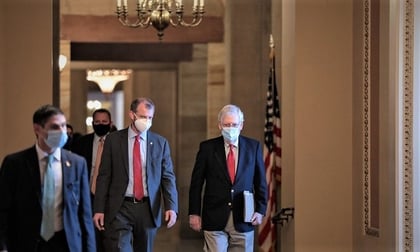House and Senate committees have agreed to a surprise medical billing deal that could favor doctors over health insurers.
The deal could let doctors take any billing disputes to arbitrators, rather than requiring doctors to accept a standard rate chart.
Resources
- An announcement of the surprise billing deal, with a link to the legislative text and a section-by-section summary, is available here.
- An article about a 2019 surprise medical bill hearing is available here.
Here are the congressional leaders who announced the deal:
- House Energy and Commerce Committee: Rep. Frank Pallone Jr., D-N.J., the chairman, and Rep. Greg Walden, R-Ore., the highest ranking Republican.
- House Ways and Means Committee: Rep. Richard Neal, D-Mass., the chairman, and Rep. Kevin Brady, R-Texas, the highest ranking Republican.
- House Education and Labor Committee: Rep. Robert Scott, D-Va., the chairman, and Rep. Virginia Foxx, R-N.C., the highest ranking Republican.
- Senate Health, Education, Labor, and Pensions Committee: Sen. Lamar Alexander , R-Tenn., the chairman, and Sen. Patty Murray, D-Wash., the highest ranking Democrat.
Bloomberg is reporting that House Speaker Nancy Pelosi pushed for the deal and wants to put it in a year-end legislative package, but the top Senate leaders have not endorsed the deal.
Health care provider groups and insurer groups have agreed on the idea that patients should be protected from surprise medical bills, but they have been battling for months over whether a surprise billing law should require insurers and providers to use a standard fee schedule or an arbitration process to resolve disputes.
Matt Eyles, president of America’s Health Insurance Plans, put out a statement objecting to the arbitration-based approach built into the deal.
“No one should ever face a surprise medical bill that can lead to financial ruin,” Eyles said in the statement. “While we continue to analyze the bill in all its complexities, we continue to believe strongly that any real solution must be clear and straightforward for consumers, and must protect patients by relying on fair, market-based prices based on locally negotiated rates — without loopholes. That’s how to ensure their health care costs remain more affordable.”
Surprise Billing Basics
Policymakers in Washington use the term “surprise billing” to refer to cases in which patients have reasonable expectations of receiving care for in-network prices but end up receiving big bills based on out-of-network rates.
Some of those incidents involve patients who are rushed to hospitals for emergency care, and who have no real chance to choose their providers.
The other incidents involve patients who go to hospitals in their health plans’ provider networks for care and end up receiving some services, such as anesthesiology services, from out-of-network doctors.
When patients get emergency care from in-network doctors, or hospital care from in-network hospitals and in-network doctors, provider network agreements spell out how much the doctors and hospitals can charge, and how much any deductibles, co-payments and coinsurance amounts will be. The agreements usually prohibit the providers from billing in-network patients for additional amounts.









 December 14, 2020 at 10:04 AM
December 14, 2020 at 10:04 AM











